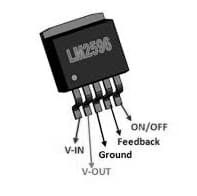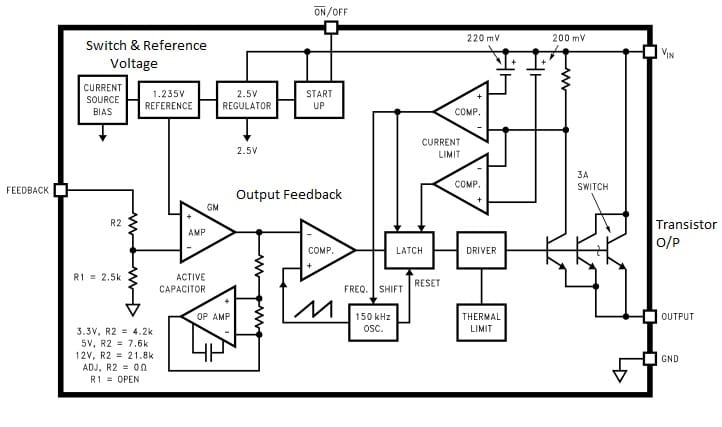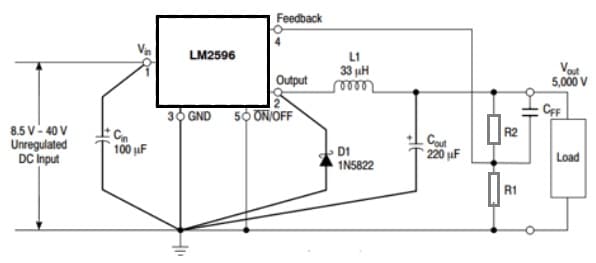A step-down (buck converter) is a DC-to-DC converter that reduces voltage when current is increased from its input supply to its load. These converters provide much better power efficiency than linear regulators. Its efficiency is frequently over 90%, which makes it very useful for different tasks like changing the main supply voltage of a computer. So, step-down converters normally have a minimum of two semiconductors like a transistor and a diode, while current buck converters often change the diode through a second transistor for synchronous rectification. These converters normally operate with a switching frequency that ranges from 100 kHz to MHz. Thus, this article elaborates on the LM2596 IC, pinout, features, specifications, and applications.
What is LM2596 IC?
The LM2596 is a monolithic voltage regulator IC, used for the simple and suitable design of a buck converter or step−down switching regulator. This regulator is available within a 5−lead TO−220 and D2PAK surface mount packages. So it can drive a 3 A load with the outstanding line & load regulation.
This IC is available within an adjustable output version which is compensated internally to reduce the number of exterior components to make the power supply design. So we know that the LM2596 converter is an SMPS, thus its efficiency is much higher as compared to three−terminal linear regulators, particularly with high input voltages. The LM2596 voltage regulator IC works at 150 kHz switching frequency thus allowing small-size filter components.
LM2596 IC Working
The LM2596 monolithic IC works like a DC-to-DC buck converter which steps down an input voltage from higher to lower. This IC is available in fixed o/p voltages from 3.3 Volts, 5 Volts, and 12 Volts and an adjustable output version. So this series of regulators operates at a 150 kHz switching frequency by allowing tiny-sized filter components.
The LM2596 IC includes a feedback loop that contrasts the output voltage with a reference voltage. If there is a difference, then this IC adjusts the switching FETs duty cycle to maintain the stable output voltage. This IC includes an internal voltage reference that simply sets the standard for contrasting the output voltage.
Some LM2596 versions have in-built protection features like current limiting and thermal shutdown. Thus, this is a switch-mode power supply or SMPS which makes it very efficient as compared to linear regulators, particularly with high input voltages.
LM2596 IC Pin Configuration:
The pin configuration of LM2596 IC is shown below. This IC includes 5-pins which are discussed below.

LM2596 IC Pin Configuration
- Pin-1 (Vin): This is a positive input terminal that provides supply to the regulator IC. To avoid large transient voltages from emerging at the input terminal then a tantalum capacitor or aluminum must be connected between the i/p terminal & the GND.
- Pin-2 (Output): This is an output terminal of the IC which is coupled to an inductor & a diode..
- Pin-3 (Ground): It is a GND terminal of an IC.
- Pin-4 (Feedback): This feedback pin of the IC is used to feed back the o/p voltage to make sure that the o/p voltage is precise and stable.
- Pin-5 (ON/OFF): This ON/OFF pin is used to disconnect the IC with a logic level, decreasing the input current about to 80µA. When this pin is pulled below 1.3V then turn on the LM2596 IC and when this pin is pulled above 1.3V turn off the IC.
Features & Specifications:
The features and specifications of LM2596 IC include the following.
- LM2596 IC is a DC-to-DC converter IC.
- It is available in TO−220 & D2PAK surface mount packages.
- The mounting style is SMD or SMT.
- Invented by Texas Instruments
- Its topology is Buck.
- The output voltage range is adjustable from 1.23 V to 37 V.
- The input voltage range is up to 40 V.
- The output current is 3 A.
- It has a fixed 150 kHz frequency internal oscillator.
- It has TTL shutdown ability.
- Its typical power standby mode is 80 A.
- It has internal loop compensation, current limit protection, and thermal shutdown.
- Moisture Sensitivity Level or MSL is 1.
- These ICs are Pb−Free.
- It needs four external components only.
- Minimum operating temperature ranges from – 40 C to + 125 C.
- The operating current supply is 5 mA
- The minimum voltage supply is 4.5 V.
Equivalent & Alternative ICs:
Equivalent LM2596 ICs are; LM2576, ACT4523, BD9876, etc. Alternatives to LM2596 ICs are; LM2575S-5.0, LM2596S-5.0, LM2576S-5.0, UCC27525D, UCC27511DBVR, LM124DR, RC4558DRG4, LM224DR, LM324DR, LM2904P, UCC27523, LMV358QD, CD4001BM, OPA333, etc.
LM2596 IC Structure
The LM2596 IC includes several components; a reference voltage source feedback loop & error amplifier, protection circuits, control logic, and internal switch FET which are discussed below.
The reference voltage source works as the baseline for mainly voltage comparison. So its stability is supreme to ensure precise voltage regulation.
The feedback loop and error amplifier measure & adjust the output voltage -continuously. So it plays a key role in maintaining o/p stability. So this mechanism simplifies regulation processes within practical applications to make it necessary for fine-tuning.
Protection circuits include thermal shutdown & current limit features which protect the IC from potential damage from excessive current or overheating. Thus, these circuits avoid system failures and improve the lifetime of devices within high-demand environments such as industrial or automotive settings.

LM2596 IC Structure
Control logic ensures exact timing & switching frequency mainly for the FET switches. So this impacts the efficiency & performance of the regulator significantly. Fine-tuning control logic parameters can clearly develop energy efficiency & operational reliability. So it is significant for both large-scale industrial systems and consumer electronics.
Internal switch FET changes the current pathways to control voltage. The overall system performance can be enhanced by changing the current flow dynamically.
LM2596 DC-to-DC Buck ConverterIC Circuit Diagram
The LM2596 DC-to-DC buck converter IC circuit is shown below. Here, the LM2596 IC in this circuit is fairly simple to use because of its minimal requirement of components. The unregulated voltage can be provided to pin 1 or Vin across a filter capacitor to decrease input noise. So the pin-5 (ON/OFF) or enable pin must be connected to GND to allow the voltage regulator. If this regulator IC is made high then it will go into shutdown mode to avoid leakage current. So this feature is very helpful to save input power whenever operating through the battery.

LM2596 DC-to-DC Buck ConverterIC Circuit Diagram
The feedback pin of this IC is a crucial pin that decides the output voltage. Thus this pin detects the output voltage and changes the switching frequency of the internal switch to generate the preferred output voltage based on the o/p voltage value. At last, an LC filter is utilized to retrieve the o/p voltage throughout pin-2.
Difference between LM2576 IC and LM2596 IC
The differences between LM2576 IC and LM2596 IC include the following.
|
LM2576 IC |
LM2596 IC |
| LM2576 is a step-down switching voltage regulator designed by TI (Texas Instruments). | LM2596 is a switching voltage regulator produced by Texas Instruments. |
| This IC is available in a TO-220 package. | LM2596 IC is available in TO-263 and TO-220 packages. |
| This IC works on the switching principle to adjust the output voltage. | It works by using a switching topology for the regulation of voltage. So it results in better efficiency as compared to other linear regulators. |
| This IC changes the o/p voltage by switching on and off the input voltage quickly. | It regulates the o/p voltage by switching on and off the input voltage at higher frequencies. |
| Its alternative models are; LM2577, LM2596S, LM317, LT1083, AP1501, MC34063,etc. | Alternative models of LM2596 ICs are;
LM2597, LM2575, LM2574, MP2307, XL4015,etc. |
| Its voltage ranges from 1.23V to 40V. | Its voltage supply ranges from 1.25V to 40V. |
| The frequency switching of this IC is 52kHz | Its frequency switching is 150kHz. |
| Output voltages are; 3.3V, 5V, 12V and 15V. | Its output voltages are 3.3V, 5V, 12V and adjustable. |
| It is built with thermal shutdown & current limit safety for consistency. | It is built with over-temperature protection & current limiting for improved reliability. |
LM2596 IC PWM Control Principle
The LM2596 IC attains accurate output voltage regulation through the PWM control method. So this method involves regulating the switching transistor’s duty cycle, which varies between ON & OFF conditions. Whenever the input voltage goes above the preferred output voltage, then this transistor will be turned on. In this ON condition, the inductor will store energy when the capacitor discharges to supply current to the connected load.
Whenever the input voltage is below the preferred output voltage, the switching transistor will be turned off. So the stored energy within the inductor will be released in this condition, thus the capacitor gets energy to ensure a constant and precise output voltage.
Further to clarify, this PWM control mechanism permits the control system to respond dynamically to changes within input voltage & load conditions. This mechanism was first applied in industrial applications, so it has become a foundation in modern power electronics.
A significant benefit of using PWM practically within the LM2596 IC is its efficiency because the transistor works within full-on (or) full-off conditions. So it reduces the dissipation of power as compared to other linear voltage regulators. These are less efficient because of constant conduction losses.
This efficiency saves energy and also decreases thermal management challenges by allowing more compact & gainful design within a variety of applications like power supplies for battery-powered devices and communication systems. LM2596 voltage regulator in automotive electronics ensures that onboard devices get stable power despite the unstable supply from the electrical system of the vehicle. So this reliability is essential for secure and efficient critical systems operation.
Advantages & Disadvantages
The advantages of LM2596 IC include the following.
- LM2596 IC provides all the active functions mainly for a step-down switching regulator.
- The LM2596 regulator is suitable preferably for a simple and convenient step−down switching regulator design.
- This voltage regulator is designed to handle up to 40V input voltages, efficiently stepping them down to generate a stable and lower output voltage that can range from 3V to 35V.
- Its conversion efficiency is 92%.
The disadvantages of LM2596 IC include the following.
- LM2596 IC causes significant radio frequency interference (RFI) and electromagnetic interference (EMI) issues.
- It should handle the variations in input voltage.
- The ground wiring & output capacitor of this IC can cause issues.
- These ICs need a minimum load to attain proper regulation.
- The input capacitor of this IC should be rated as a minimum of 1.5 times i/p voltage.
Applications
The applications of LM2596 IC include the following.
- The LM2596 DC-DC converter IC is a significant component within many voltage regulator applications and power supply systems.
- It is useful mainly for designers and engineers to test and process circuits in the development stage.
- It is used for battery-powered devices because it changes input voltages from higher to stable lower o/ps to progress the device performance & expand the battery life.
- Its compact design & adjustable feature will make it a good choice for incorporating components into electronic systems.
- It is suited ideally for a simple and convenient step−down switching regulator design.
- This voltage regulator IC is used to reduce the voltage (or) to drive load below 3A.
- It is utilized in little SMPS circuits, small RPS circuits, variable voltage generators, etc.
- The LM2596 IC is used across a variety of domains like power supply design, LED lighting systems, electronic prototyping, and wireless communication devices.
Please refer to this link for the LM2596 Datasheet.
Thus, this is an overview of LM2596 IC, pinout, features, specifications, circuit, working, pros, cons, and applications. So this is a DC-DC converter IC which plays a key role in many power supply systems. It is robust, has excellent performance, and versatile IC that is efficient with a broad voltage range. So this IC itself has been verified as a very efficient voltage regulator if you are focusing on capacitor types, inductor specifications, FET functionalities, or diode characteristics. So. here is a question for you, what is BD9876 IC?